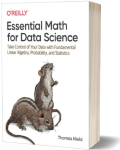Essential Math for Data Science
Data Science
Book Details
Book Title
Essential Math for Data Science
Author
Thomas Nield
Publisher
O'Reilly Media
Publication Date
2024
ISBN
9781098102937
Number of Pages
1175
Language
English
Format
File Size
6.3MB
Subject
Data Science
Table of Contents
- Preface
- Chapter 1. Basic Math and Calculus Review
- Number Theory
- Order of Operations
- Variables
- Functions
- Summations
- Exponents
- Logarithms
- Euler’s Number and Natural Logarithms
- Limits
- Derivatives
- Integrals
- Conclusion
- Exercises
- Chapter 2. Probability
- Understanding Probability
- Probability Math
- Binomial Distribution
- Beta Distribution
- Conclusion
- Exercises
- Chapter 3. Descriptive and Inferential Statistics
- What Is Data?
- Descriptive Versus Inferential Statistics
- Populations, Samples, and Bias
- Descriptive Statistics
- Inferential Statistics
- The T-Distribution: Dealing with Small Samples
- Big Data Considerations and the Texas Sharpshooter Fallacy
- Conclusion
- Exercises
- Chapter 4. Linear Algebra
- What Is a Vector?
- Linear Transformations
- Matrix Multiplication
- Determinants
- Special Types of Matrices
- Systems of Equations and Inverse Matrices
- Eigenvectors and Eigenvalues
- Conclusion
- Exercises
- Chapter 5. Linear Regression
- A Basic Linear Regression
- Residuals and Squared Errors
- Finding the Best Fit Line
- Overfitting and Variance
- Stochastic Gradient Descent
- The Correlation Coefficient
- Statistical Significance
- Coefficient of Determination
- Standard Error of the Estimate
- Prediction Intervals
- Train/Test Splits
- Multiple Linear Regression
- Conclusion
- Exercises
- Chapter 6. Logistic Regression and Classification
- Understanding Logistic Regression
- Performing a Logistic Regression
- Multivariable Logistic Regression
- Understanding the Log-Odds
- R-Squared
- P-Values
- Train/Test Splits
- Confusion Matrices
- Bayes’ Theorem and Classification
- Receiver Operator Characteristics/Area Under Curve
- Class Imbalance
- Conclusion
- Exercises
- Chapter 7. Neural Networks
- When to Use Neural Networks and Deep Learning
- A Simple Neural Network
- Backpropagation
- Using scikit-learn
- Limitations of Neural Networks and Deep Learning
- Conclusion
- Exercise
- Chapter 8. Career Advice and the Path Forward
- Redefining Data Science
- A Brief History of Data Science
- Finding Your Edge
- What to Watch Out For in Data Science Jobs
- Does Your Dream Job Not Exist?
- Where Do I Go Now?
- Conclusion
- Appendix A. Supplemental Topics
- Appendix B. Exercise Answers
- Index
